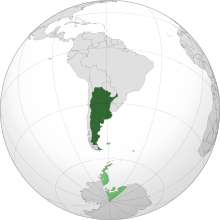
Back Аргентина Abkhazian Argentina ACE Аргентинэ ADY Argentinië Afrikaans Argentinien ALS አርጀንቲና Amharic Argentina AMI Archentina AN Argentina ANG अर्जेंटीना ANP
Argentine Republic República Argentina (Spanish) | |
|---|---|
Motto:
| |
Anthem:
| |
| Sol de Mayo[1] (Sun of May)  | |
 Mainland Argentina shown in dark green, with territorial claims shown in light green | |
| Capital and largest city | Buenos Aires 34°36′S 58°23′W / 34.600°S 58.383°W |
| Official languages |
|
| Regional languages |
|
| Other languages | Argentine Italian, English language, Italian, German, Chinese, French, Arabic, Portuguese, Hindi, Russian, Japanese, Dutch, Turkish |
| Ethnic groups | |
| Demonym(s) | Argentine |
| Government | Federal presidential constitutional republic |
| Javier Milei | |
| Victoria Villarruel | |
| Martín Menem | |
| Horacio Rosatti | |
| Legislature | Congress |
| Senate | |
| Chamber of Deputies | |
| Independence from Spain | |
| 25 May 1810 | |
• Declared | 9 July 1816 |
| 1 May 1853 | |
| 29 April 1857 | |
| Area | |
• Total | 2,780,400 km2 (1,073,500 sq mi) (8th) |
• Water (%) | 1.57 |
| Population | |
• 2014 estimate | 42,669,500[8] |
• 2010 census | 40,117,096 (32nd) |
• Density | 14.4/km2 (37.3/sq mi) (212th) |
| GDP (PPP) | 2014 estimate |
• Total | $927.382 billion[9] (25th) |
• Per capita | $22,101[9] (55th) |
| GDP (nominal) | 2014 estimate |
• Total | $536.155 billion[9] (24th) |
• Per capita | $12,778[9] (60th) |
| Gini (2011) | medium |
| HDI (2013) | very high · 49th |
| Currency | Peso ($) (ARS) |
| Time zone | UTC−3 (ART) |
| Date format | dd.mm.yyyy (CE) |
| Driving side | right[b] |
| Calling code | +54 |
| ISO 3166 code | AR |
| Internet TLD | .ar |
Argentina, officially the Argentine Republic, is a country in South America. Argentina is the second-largest country in South America and the eighth-largest country in the world.
Spanish is the most spoken language, and the official language, but many other languages are spoken. There are minorities speaking Italian, German, English, Quechua and even Welsh in Patagonia.
In eastern Argentina is Buenos Aires, the capital of Argentina, it is also one of the largest cities in the world. In order by number of people, the largest cities in Argentina are Buenos Aires, Córdoba, Rosario, Mendoza, La Plata, Tucumán, Mar del Plata, Salta, Santa Fe, and Bahía Blanca.
Argentina is between the Andes mountain range in the west and the southern Atlantic Ocean in the east and south. It is bordered by Paraguay and Bolivia in the north, Brazil and Uruguay in the northeast, and Chile in the west and south. It also claims the Falkland Islands (Spanish: Islas Malvinas) and South Georgia and the South Sandwich Islands. Most citizens of the Argentine Republic are descendants of immigrants from Europe. They are united by citizenship and not necessarily by ethnicity. Most Argentinians embrace both their ethnic origins and Argentinian nationality.
- ↑ Crow 1992, p. 457: "In the meantime, while the crowd assembled in the plaza continued to shout its demands at the cabildo, the sun suddenly broke through the overhanging clouds and clothed the scene in brilliant light. The people looked upward with one accord and took it as a favorable omen for their cause. This was the origin of the ″sun of May″ which has appeared in the center of the Argentine flag and on the Argentine coat of arms ever since."; Kopka 2011, p. 5: "The sun's features are those of Inti, the Incan sun god. The sun commemorates the appearance of the sun through cloudy skies on May 25, 1810, during the first mass demonstration in favor of independence."
- ↑ Departamento de Derecho y Ciencias Políticas de la Universidad Nacional de La Matanza (14 November 2011). "Historias de inmigrantes italianos en Argentina" (in Spanish). infouniversidades.siu.edu.ar.
Se estima que en la actualidad, el 90% de la población argentina tiene alguna ascendencia europea y que al menos 25 millones están relacionados con algún inmigrante de Italia.
- ↑ "Argentina inicia una nueva etapa en su relación con Japón". www.telam.com.ar.
- ↑ Clarín.com (27 September 2010). "La comunidad china en el país se duplicó en los últimos 5 años".
- ↑ "국가지표체계". www.index.go.kr.
- ↑ "WebINDEC – Poblaci Censo 2010". www.indec.gov.ar. Archived from the original on 2018-08-03. Retrieved 2019-02-06.
- ↑ "The World Factbook — Central Intelligence Agency". www.cia.gov. Archived from the original on 2007-06-12. Retrieved 2019-02-06.
- ↑ "Cuadro 1. Población estimada al 1 de julio de cada año calendario por sexo. Total del país. Años 2010–2040". Censo Nacional de Población, Hogares y Viviendas 2010 (in Spanish). Buenos Aires: INDEC – Instituto Nacional de Estadística y Censos. 2010. Archived from the original (XLS) on 8 June 2014. Retrieved 13 March 2015.
- ↑ 9.0 9.1 9.2 9.3 "Argentina". World Economic Outlook Database, October 2014. International Monetary Fund. 2 November 2014.
- ↑ "GINI index (World Bank estimate)". World Bank. Retrieved 19 February 2015.
- ↑ "Human Development Report 2014 – Summary" (PDF). New York, NY, USA: United Nations Development Programme. 2014. pp. 15, 16. Archived (PDF) from the original on 27 July 2014.
- ↑ Ley No. 5598 de la Provincia de Corrientes, 22 de octubre de 2004
- ↑ Ley No. 6604 de la Provincia de Chaco, 28 de julio de 2010, B.O., (9092)

